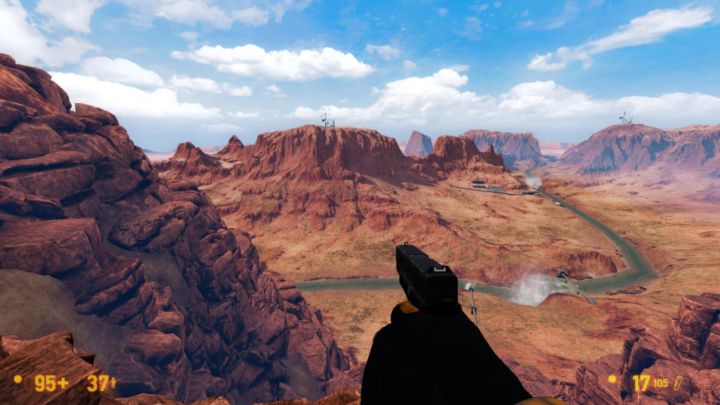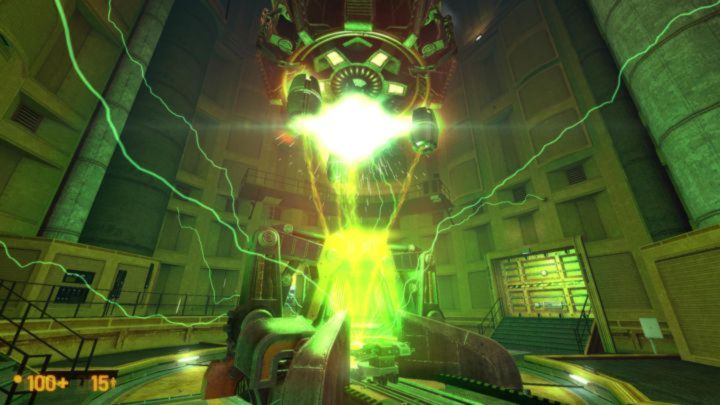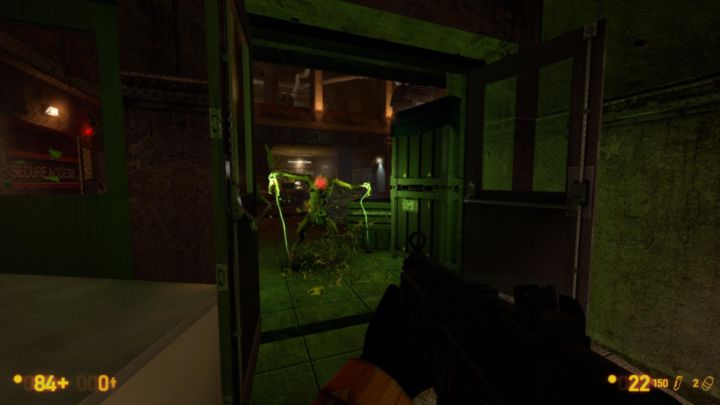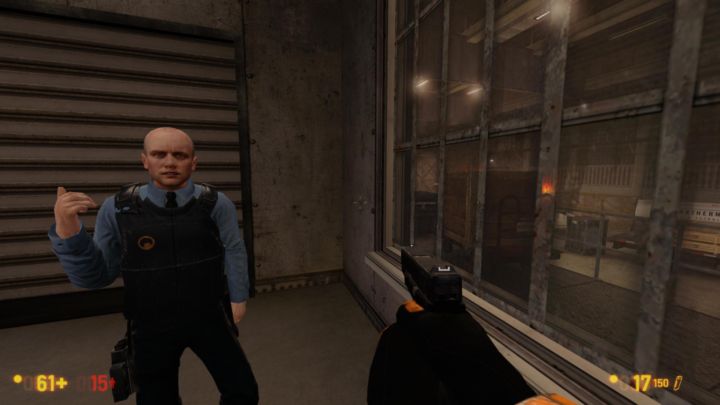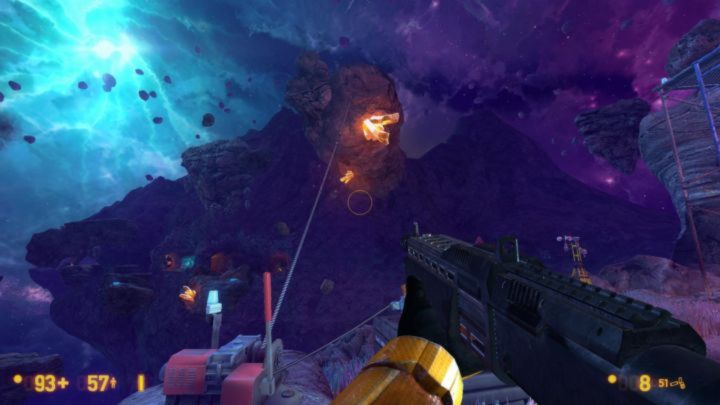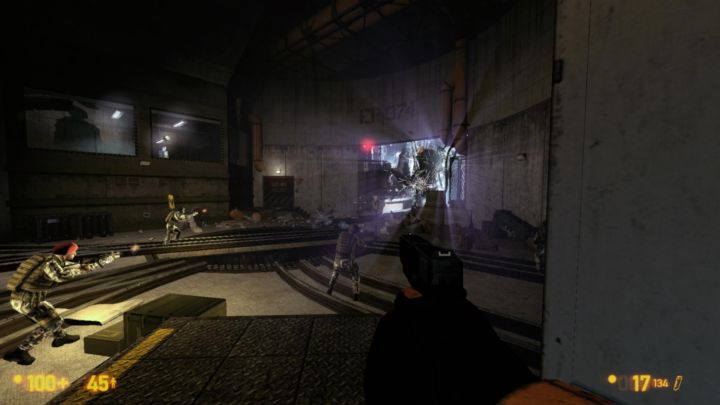Note: This review was updated on December 17, 2020 to cover the changes in Black Mesa: Definitive Edition.
The year 1998 will surely be remembered for one game. This was none other than Half-Life, Valve’s revolutionary first-person shooter which won a myriad of accolades and became the new benchmark for PC action games overnight.
And while people have been criticizing Valve since Half-Life 2 came out in 2004 for not releasing another entry in the series yet, an industrious group of fans set out to remake Half-Life not long after its award-winning sequel hit shelves. They named their remake Black Mesa, after the famous research facility where Half-Life takes place.
This is a project which had been going on for a whopping sixteen years, which came to a conclusion when the team behind the game (Crowbar Collective) recently put out a full PC release of their Half-Life remake on Steam.
And the good news is that Black Mesa succeeds at bringing Half-Life up to date, delivering the same thrills as the original game with a fresh coat of paint and other enhancements, but suffers from the same weakness as the 1998 classic: the final part of the game taking place in the alien world of Xen is a disappointment, while other flaws prevent this from being as great a first-person action experience as it could have been.
Black Mesa begins with the iconic tram ride which takes protagonist Gordon Freeman into the bowels of the Black Mesa Research Facility in rural Nevada, US. This is a sequence which has been imitated in many games since, and definitely sets the tone for what is to follow.
It’s jarring, though, to see Freeman’s tram ride interrupted by a loading message, something which takes you out of the action. This happens throughout the entire game, although thankfully these loading pauses don’t happen so often and are relatively brief.
This might be a limitation of Valve’s Source engine, the latest version of which powers Black Mesa, or simply the developers sticking to the original game’s structure, loading pauses and all. Other details reveal the fact that this is a remake of a game which is over 20 years old, such as the CRT monitors littering the Black Mesa offices once Freeman arrives at work.
It’s remarkable, though, how Half-Life’s plot, scenes and set pieces have lost none of their impact since the first game hit shelves back in 1998, and all are wonderfully recreated in Black Mesa. Seeing Freeman don his hazard suit, indicators for health and energy appearing onscreen and hearing the HEV suit voice again (well, Black Mesa’s version of it) is still heart warming.
And once in the test chamber were the famous “resonance cascade” experiment goes wrong and all hell breaks loose, I still felt the same sense of awe and wonder as when I played the original game for the first time all those years ago.
After things go awry at the Black Mesa facility, creatures from the alien world of Xen start warping in. Half-Life fans have gotten to know these creatures’ names by heart over the years: enemies like the Headcrab (which bear a resemblance to the face huggers in Alien), the Barnacles (which stick to ceilings ready to catch passersby with their slimy tongues) and the Houndeyes, alien dog-type enemies which emit a shock wave which can injure Freeman and destroy objects. There are plenty of other enemies roaming Black Mesa, including the zombies, giant lizard-like creatures which spit acid and the alien grunts, which make an appearance later in the game.
Thankfully, though, you get to acquire plenty of weapons with which to dispatch these foes in your journey through Black Mesa. These include Half-Life’s iconic crowbar, a pistol, shotgun, submachine gun, crossbow, a variety of explosives and other, experimental, energy-based weapons you get hold of later on. You also get to play with a couple of alien weapons too, which are as cool to use in Black Mesa as they were in the original Half-Life game all those years ago. And then there’s the rocket launcher when you need that extra firepower too…
If anything, there may be too many weapons in Black Mesa, but at least the game gives you plenty of options to dispatch the many foes you encounter in your journey.
It’s also a plus how the game’s early weapons remain useful throughout the game: the crowbar remained my favorite weapon with which to smash Headcrabs and blast crates open throughout, while there’s nothing I loved more than blasting Barnacles to death with a good shotgun blast. The shotgun’s alternate fire mode does turn some enemies into a pile of gory goo a bit too easily though, making it feel overpowered at times. And a powerful revolver you find at some point in the game can put any of the game’s enemies to rest with a couple of shots. Using it during a section of the game taking place in a canyon really made me feel like a badass cowboy.
The crossbow, though, remained my preferred weapon to fight the enemy soldiers which enter the scene in one of the early chapters of the game. This is because this weapon can kill the marines in one shot, and also has a handy zoom in function which makes aiming across a distance easier.
Actually, it’s possible to zoom in while wielding any weapon in the game by hitting the game’s zoom key, but when playing with a controller the default layout is such that it’s not possible to zoom in and fire at the same time (unless you’re using a weapon like the crossbow, which has a built-in zoom function that is). This means that fighting the marines while using the gamepad can be quite a daunting task, as these guys move quickly and hit hard, meaning it’s easier to dispatch these guys using mouse and keyboard than a controller.
Despite this, fighting the marines remains one of the best parts of Black Mesa as was the case in the original Half-Life – they have definitely better AI than the often dumb aliens. Actually, I encountered some odd enemy behavior when fighting alien creatures like the Headcrabs and Vortigaunts (humanoid-like enemies which fire lighting at the player). These would sometimes strangely turn their back on me before resuming their attacks, or in the case of the Vortigaunts, run away for no reason.
Also, the game resorts a bit too often to that cheap trick of spawning enemies behind your back – enemies like Headcrabs would “warp in” behind me, catching me by surprise. Although it’s clear this is more justified here than in other games, as protagonist Freeman had opened a portal to an alien world when that experiment goes wrong early in the game.
It’s also remarkable how the early survival horror feel of the game transitions to all out action in the game’s “Surface Tension” level, which has you going up against a tank, helicopter and scores of marines in an action-packed chapter that rivals anything the best first-person action games have offered to date.
The game, though, is at its best in the early levels, when you’re skulking in the dark armed only with pistol and crowbar, wary of headcrabs leaping from a corner, ready to devour your face. Or when you’re crawling in air ducts not knowing what you will encounter when you emerge at the other end…
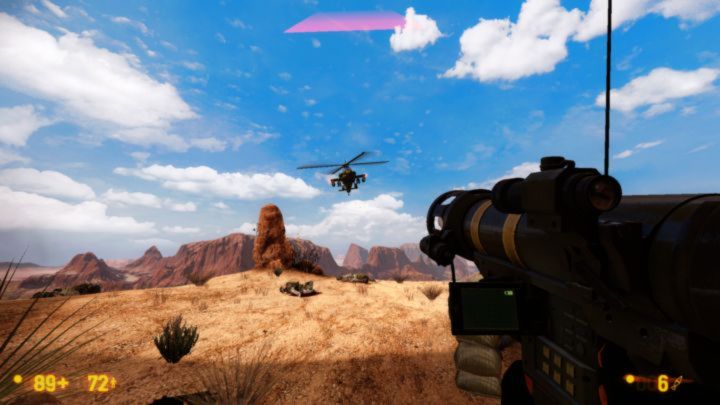
You can tilt the fight between man and helicopter in your favor thanks to the game’s rocket launcher.
Thankfully, you often encounter a friendly face or two in your journey through the Black Mesa facility, as scientists and guards are on hand to help Freeman. Guards can tag along and help you take out the baddies, but don’t make much of a difference in combat though. Both the guards and scientists do have some interesting things to say about what’s going on at Black Mesa, and this is one of the ways the game tells its story.
With no perspective changes (everything is seen through Freeman’s eyes) and a silent protagonist, listening to the survivor’s stories can get you clued up on current events in Black Mesa, and this way of telling the game’s story is just as effective today as when the original Half-Life came out all those years ago.
It’s also remarkable how the Black Mesa Research Facility feels like a real place – from signs warning people not to smoke, or asking them to wear ear protection gear, scientists discussing experiments before things turn sour, and realistic machinery in the game’s industrial settings to the various offices, warehouses and laboratories you trek through, this really feels like a place where people would go about their daily routine. Also, seeing fire sprinklers in action to contain fires in certain scenes once all hell breaks loose adds to the illusion of realism.
It’s clear developer Valve went for realism when making the original Half-Life, and none of this has been lost in Crowbar Collective’s rendition of the game.
Some may not like some of the game’s old school mechanics, though. While you can recharge the environmental suit’s energy and regain health at energy stations throughout the game, there’s no regenerating health here. Also, there’s no map or onscreen objectives either. Sometimes one of Black Mesa’s scientists will give you pointers about where you’re supposed to go next, but the game often left me wanting for a map, especially when I was trekking through a maze of conveyor belts in the “Residue Processing” level, and also in the game’s alien world of Xen.
Ah, Xen. After Freeman makes his jump at some point in the game, he ends up in the alien world, ready to take the battle to the enemy… The thing is, these levels felt anti-climatic after all the action which had come before back in 1998. My memory is a bit hazy regarding Xen, but I remember it involved a lot of tedious jumping in a zero-g environment and definitely wasn’t comparable to the earlier levels in the Black Mesa Research Facility.
Crowbar Collective, though, has added to this part of the game, expanding what was seen in the original Half-Life in its Black Mesa remake. And the Xen levels are pretty substantial here, taking up more than 6 of the 30+ hours I spent playing the game.
Xen does look suitably otherworldly too, with giant rock platforms floating in space (Freeman is equipped with boosters to perform long jumps on Xen as in the original game), and all sorts of alien vegetation, caves, waterfalls and lakes to wade through. Strange flying creatures roam the skies above, and it’s nice to see enemy creatures like the Barnacle in their natural habitat. There’s also an underwater version of the Barnacle and a variant of the Houndeye enemy which explodes on contact with the player which I don’t recall seeing in the original game, and which are nice additions to the game.
Navigating the alien environments did make me wish more for some kind of onscreen map though. Sometimes I found making progress through Xen tedious, as the environments are large and there’s not always a clear path to the destination.
At least this version of Xen gave me more clues about what the Black Mesa scientists were doing on the alien world: the laptops lying around and other equipment suggests some knew more about Xen than they were telling…
Making progress through this section of the game at times involves puzzles which require you to connect cables to alien power sources, which is boring though. Things pick up in the next level though, when you’re pitted against the Gonarch – a huge spider-like creature which follows you through most of the level. But while the Gonarch fight is exciting at points, it drags on and on, making me wish it was over before the end.
After dealing with the Gonarch, more tedium follows as you’ve got to trek through alien factories, riding conveyor belts and solving tedious puzzles involving alien machinery and connecting cables to alien plugs.
There’s also an abundance of the game’s flying “controller” enemies, which are fast and have a powerful energy attack and require precision aiming to take down, and which can be a little tricky to put down when playing with a gamepad (good use of the zoom button – or perhaps the crossbow – comes in handy here).
Controller enemies can also take control of Vortigaunts and make them attack the player, something which did not make me feel so guilty for putting down a few of these non-hostile folks earlier on.
There’s also a sequence which echoes Half-Life 2’s disappointing finale, and which takes place before the final boss fight. You’re given unlimited ammo for one of your most powerful weapons and have to fight scores of enemies, in what I found to be a tedious gameplay sequence truth be told.
Excitement returns when Freeman is pitted against the final boss (the Nihilanth) in an awe-inspiring fight. But overall, though, Xen doesn’t live up to the rest of the game as was the case in the original Half-Life game, and it’s clear to me Crowbar Collective have definitely been better at remaking Half-Life than at adding fresh content to it.
I also encountered noticeable frame drops at some points in Xen, and a considerable slowdown and crash while playing the first to last chapter (which is named “Interloper” in the game). I was only able to complete this level after restarting it, as it would eventually keep crashing to desktop after reloading my saved game… Thankfully, you can choose which of the game’s eighteen chapters you wish to start a new game from Black Mesa’s main menu.
Aside from the slowdown and crash during my time on Xen, elsewhere in the game frame rates are not as buttery smooth as I was hoping for, even with anti-aliasing turned off and playing at 1080p on a PC which exceeds the game’s recommended system requirements, which is a pity.
Regarding the graphics, these are a bit of a mixed bag: facial animations and lighting courtesy of Valve’s Source engine stand out, even if at times this looks like a game from 2005, which is not surprising taking into account this is about the time developer Crowbar Collective began work on Black Mesa. The Xen levels do look more like a recent game though.
Black Mesa also makes use of the physics available in the Source engine, meaning you’ll see zombies hurling barrels at you in a realistic way, and objects in general behaving like in the real world such as boxes breaking up as a result of explosions. And despite this not boasting cutting edge visuals as stated earlier, it’s still leagues ahead of the original Half-Life and Valve’s own enhanced edition (Half-Life: Source) too.
The music, though, is a bit hit and miss. There’s some good music to accompany the action, but overall I found the music to be something of a disappointment as some of it could be in this Half-Life remake or in any other game, feeling slightly generic and ill-fitting at times. Some tunes heard in the game’s alien world of Xen sound like they would fit better in a fantasy game like the Elder Scrolls, for instance. The default music volume is also overpowering, and I had to dial it down to below fifty percent in the game’s menu.
There’s some bad voice acting here too. A marine making an announcement to the Black Mesa facility at some point in the game sounds like a teenage disc jockey at a party, although scientists, guards and other characters sound pretty good overall and are a match for the voices heard in the original game.
The game also didn’t recognize my Xbox controller initially, but this was fixed in a subsequent patch. I did find the default gamepad layout slightly inconvenient though, as it did not allow me to use the zoom function and fire simultaneously, and the game also did not let me map the zoom function to a more convenient button via the menu. In the end I had to use a third-party patch which offered a better controller layout, an unnecessary inconvenience.
Plus, sometimes after loading or quick saving my character would be looking up after resuming the game, but this is a minor issue.
Black Mesa also offers a multiplayer mode – this is a classic deathmatch in which one side attempts to score more kills than the other before time runs out. This is a frantic and fast paced experience with Black Mesa’s vast array of weapons allowing a variety of strategies – you can hit opponents from afar with the crossbow, shotgun them at a close distance or setup a trap with the laser tripwire – the possibilities are endless.
Also, when you’re killed by an opponent, the game clearly shows you which member of the opposing team was responsible, something which comes in handy as it’s not always clear who was behind the kill in the heat of the action, letting you know whom to get even with when your character respawns… (and despite me not having played online multiplayer for a while I was still able to score my share of frags here much to my own delight).
Black Mesa’s multiplayer can keep you going for a while, that’s for sure, but it’s the single player campaign which really counts here.
Crowbar Collective has made a few changes and enhancements to it in the definitive edition of the game (Black Mesa: Definitive Edition), although there are still a few hiccups in the game. For instance, I still had to resort to a third-party patch to get my Xbox controller to work properly with the game. Plus, there’s still no gamepad support for navigating the menus, a disappointing omission at this stage.
The Definitive Edition upgrade (which is free for existing owners of the game) has also tweaked some of the levels. The “Power Up” level for instance, has a new layout, and takes advantage of the improved lighting system in the game. This makes this and other stages in Black Mesa more atmospheric, but I found navigating through the reworked “Power Up” chapter more confusing, even if killing the giant monster in it (the Gargantua) with electricity was just as satisfying and looked flashier too thanks to the new lighting effects.
Also, the new flickering lights I came across every now and then help heighten the sense of realism, and light sources look convincing up close and at a distance in general. A few of these such as a couple of flood lights in the “On A Rail” level don’t look so convincing though (and some bits of the game are a bit too dark now too). The “On A Rail” chapter has also seen changes, as the part of the game where you have to prepare a rocket in a silo for launch and get to the control center and fire it is more action packed and there’s a bit more storytelling in it.
Levels taking place outdoors, such as the superb “Surface Tension” level also seem to have received a graphical upgrade. It’s nothing dramatic, but this combined with the more realistic lighting effects makes the outdoors more attractive to look at. I noticed more detailed backdrops in this level too, something which might not make such a difference when you’re taking down hordes of enemies, helicopters and tanks, but still nice. Plus, glass smashes to pieces in a more realistic way during firefights too…
Some enemies like the Vortigaunts and alien grunts also seem to be more aggressive in their attacks and pack a bit more punch. So do the guards who can tag along with you and help you dispatch enemies in Black Mesa, although the Definitive Edition upgrade might have brought in an AI glitch or two, as a guard following me around got stuck behind a door in the middle of a firefight, and wouldn’t move afterwards. The enemy soldiers sent to dispatch Freeman are just as cunning and aggressive as they have always been, though.
Black Mesa: Definitive Edition has also rectified an issue by which the animated background seen in the game menus was chosen at random and not belonging to the chapter you were currently at, which is nice. New in-game graphical effects like gas coming out of pipes distorting your view are also welcome, plus medical supply crates in Black Mesa are now appropriately labeled, adding to the realism.
Also, Crowbar Collective seems to have improved performance in the Definitive Edition, as I was able to bump up the resolution to 1440p on a test rig equipped with a lowly GTX 970. That is, until I reached Xen, where slowdowns forced me to go back to 1080p. Playing Xen again though, it’s clear the best Black Mesa had to offer is over once you step into the alien world.
But while Xen is a disappointment overall, it’s quite a bit more substantial than what was featured in the original Half-Life, while everything before it is an exciting and jolly entertaining experience, making this a superb remake of a video game classic. And if you’ve never played Half-Life before, you can add a couple of points to the score below. This is a great game in its own right and one of the best video game releases of the year so far, and the improvements in the Definitive Edition make this a no brainer if you’ve yet to play Black Mesa.
Black Mesa
Score: 79 / 100
Available on: PC
Reviewed on: PC (System: Intel Core i5-8400, 16 GB of RAM, Nvidia GTX 970, SSD Drive)
Publisher: Crowbar Collective
Launch date: March 6, 2020
This game was reviewed using a copy purchased for the purpose of this review.

